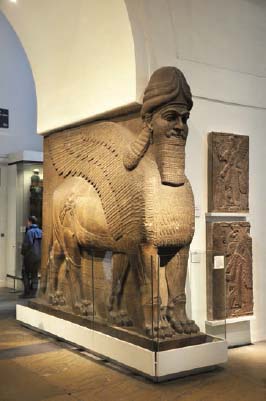Art of the Ancient World, C. 5000 B.c.e.–400 C.E.Art of the Ancient Near East |
What is a lamassu? |
A lamassu is a monumental stone sculpture famously part of Assyrian palace decoration, and serves as a protector of the palace gateway. A lamassu combines human and animal features and includes a lion or bull body, wings, a human head with full beard and eyebrows, and a total of five legs. When approached from the side the lamassu appears to be walking, and from the front, it seems to be standing firmly at attention. The lamassu from the Fortress of Sargon in the Assyrian city of Khorasabad was constructed around 720 B.C.E. and stands over fourteen feet tall. Part sculpture and part architectural feature, this giant creature keeps a watchful eye on any approaching palace visitor.

These monumental sculptures of winged bulls with human heads were used as protective palace decoration and are similar to the Sphinx that guards the entrance to the pyramids at Giza.
